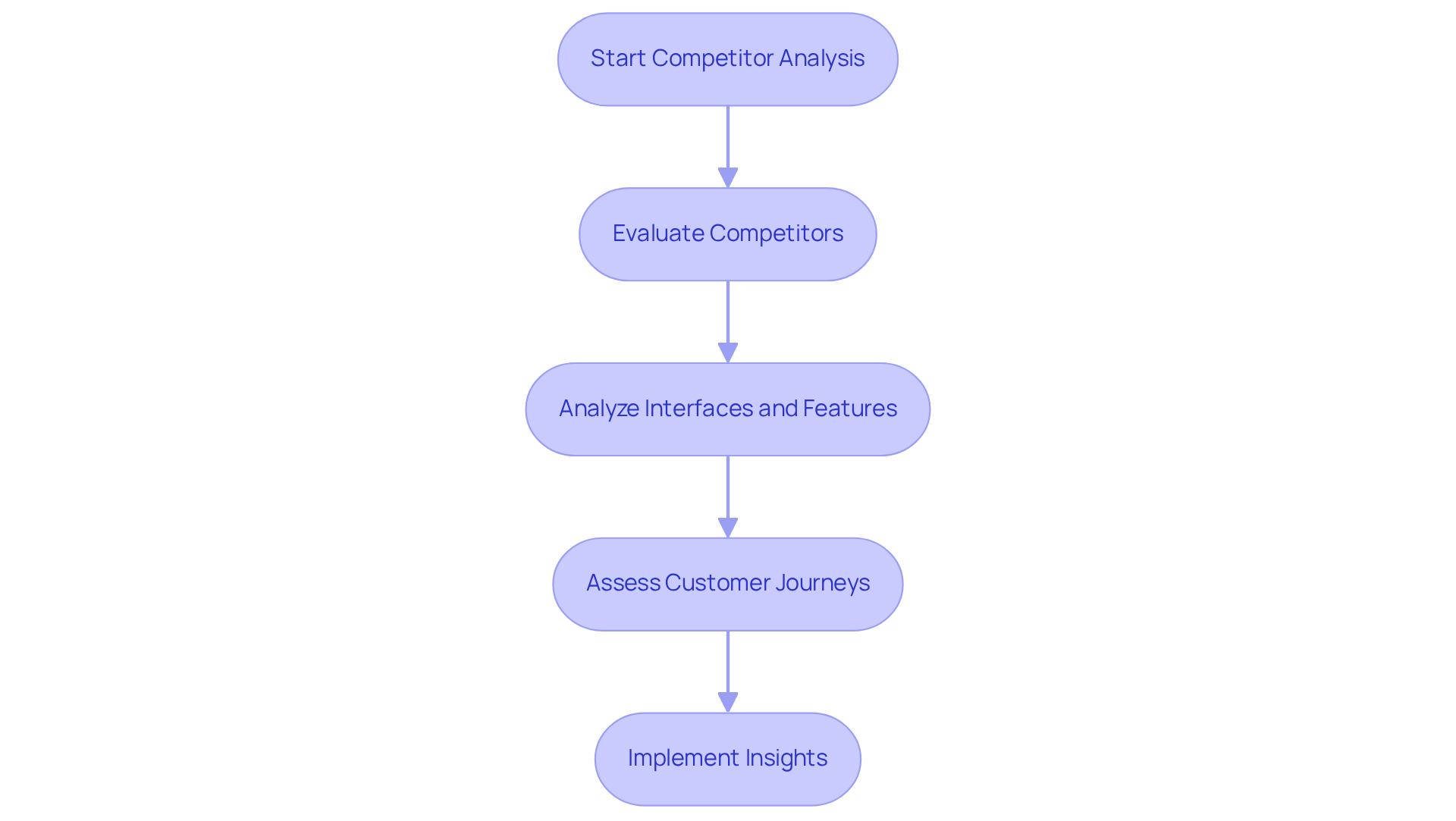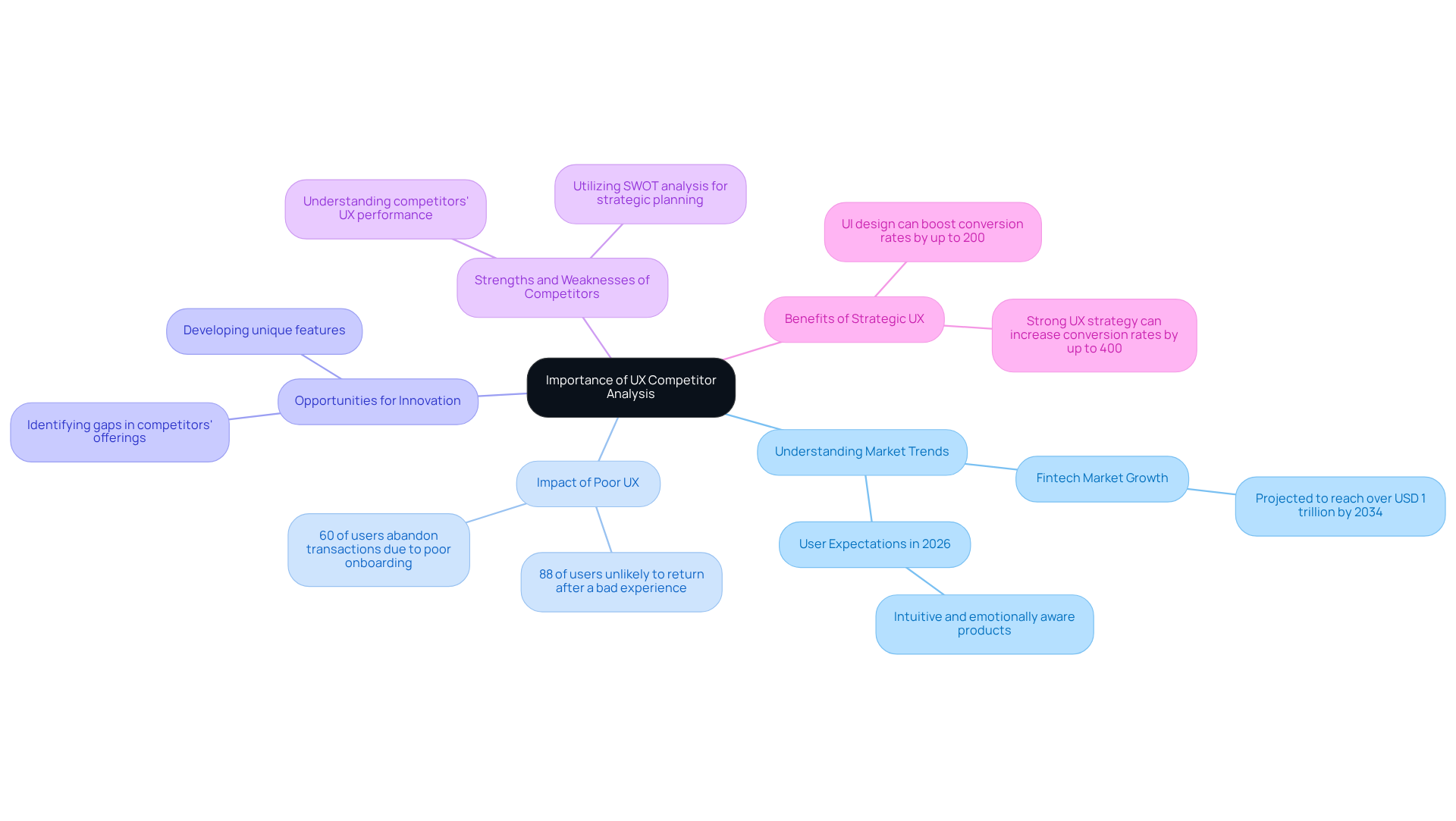Introduction
Navigating the competitive landscape of user experience (UX) can feel overwhelming for tech startups. Every interaction holds the potential to either build or break customer loyalty, and that pressure can be daunting. Imagine pouring your heart into a product, only to see users walk away after a frustrating experience. With a staggering 88% of users unlikely to return after such an encounter, the stakes couldn’t be higher. So, how can startups avoid this pitfall and foster lasting connections with their audience?
This guide is here to help. We’ll explore the essential steps of mastering UX competitor analysis, shedding light on how your rivals engage users while uncovering opportunities for innovation that can truly set your startup apart. Think of it as a supportive roadmap, equipping you with the tools you need to enhance your offerings and deepen your relationships with your audience. Together, we can navigate this journey and ensure that your startup not only survives but thrives in the competitive world of UX.
Define UX Competitor Analysis
Navigating the world of user experience (UX) can feel overwhelming, especially for tech startup founders. You might find yourself wondering how to stand out in a crowded market, where every detail matters. The challenge lies in understanding your product as well as performing a competitor analysis in UX design to see how it compares to others. This is where competitor analysis ux design plays a crucial role. It’s a structured approach for competitor analysis ux design to assess the experiences offered by your competitors, both direct and indirect. By evaluating their interfaces, features, and customer journeys, you can uncover valuable insights that inform your design choices and enhance user satisfaction.
Imagine the frustration of a potential customer who visits a website only to leave feeling confused or disappointed. Statistics reveal that 88% of users are less likely to return after a frustrating experience. This highlights the critical role of UX in retaining customers and the importance of thorough market research to avoid such pitfalls. Paul Rand once said that design is the silent ambassador of your brand, emphasizing the need for startups to truly understand their competitive landscape.
Consider the success story of Mine’d, which saw an 85% increase in customer satisfaction and an 87% boost in retention after redesigning their platform based on market research. They focused on enhancing their interface and streamlining customer journeys, proving that thoughtful UX can lead to significant improvements.
For tech startups, conducting competitor analysis ux design isn’t just beneficial; it’s essential. By utilizing competitor analysis ux design, you can understand how competitors engage their users and identify strengths and weaknesses in your own offerings. This knowledge empowers you to make data-driven enhancements that foster deeper audience engagement and provide a competitive edge in today’s fast-paced digital environment.
At RNO1, we’re here to support you on this journey. Together, we can navigate the complexities of UX and help you create experiences that resonate with your audience, ensuring your startup not only survives but thrives.

Understand the Importance of UX Competitor Analysis
For tech startups, conducting a competitor analysis ux design is not just beneficial; it’s essential. Many founders grapple with understanding market trends and what consumers truly expect. This lack of insight can lead to missed opportunities and, worse, negative user experiences. Did you know that 88% of people are less likely to return to a website after a bad interaction? This statistic highlights the importance of truly grasping what visitors need and want.
At RNO1, we understand these challenges deeply. We believe that a design-focused approach is crucial at every touchpoint. Every interaction should be crafted with intention and impact. This commitment to design-driven solutions not only enhances user experiences but also positions startups as innovative leaders in their fields. Imagine the difference it could make when your product resonates with users on a deeper level.
Moreover, a thorough competitor analysis ux design can reveal gaps in your rivals' offerings. These gaps present unique opportunities for innovation. By identifying what others lack, you can develop features that truly set your startup apart in a crowded market. It’s about finding your niche and making it shine.
Understanding your competitors' strengths and weaknesses is equally important. This knowledge allows you to position your startup effectively, increasing your chances of success. For instance, a well-crafted interface can boost conversion rates by as much as 200%, while a robust UX strategy can elevate them by up to 400%. These numbers showcase the profound impact of strategic UX choices.
By leveraging insights gained from competitor analysis ux design, you can create user experiences that not only meet but exceed expectations. This approach nurtures loyalty and fosters sustainable growth. At RNO1, we’re here to support you on this journey, ensuring that your startup not only survives but thrives.

Execute the UX Competitor Analysis Process
To effectively navigate the challenges of UX competitor analysis, let’s take a moment to explore some structured steps that can truly make a difference:
-
Identify Your Rivals: Begin by gathering a list of both direct and indirect competitors. Think of resources like Google, social media, and industry reports as your allies in creating a comprehensive overview. It’s about understanding who’s in the ring with you.
-
Define Your Goals: Take a moment to articulate what you hope to achieve with this analysis. Are you looking to refine a specific feature, enhance overall usability, or perhaps uncover emerging market trends? Clarity here can guide your efforts.
-
Analyze Rival UX: Dive into the user experience of each competitor. Focus on aspects like navigation, design consistency, accessibility, and user feedback. Tools such as Hotjar and Crazy Egg can help visualize interactions, offering valuable insights into user behavior. Remember, understanding their strengths can illuminate your path forward.
-
Conduct a Feature Comparison: Create a comparison chart that outlines key features of your product alongside those of your competitors. Identify unique features, commonalities, and gaps in your offering that could be addressed. This isn’t just about competition; it’s about finding opportunities for growth.
-
Gather Customer Feedback: Explore reviews and feedback from consumers on competitors’ products. Platforms like G2 and Trustpilot can reveal satisfaction levels and highlight pain points. Keep in mind that 32% of individuals will stop engaging with a brand after just one negative experience. This underscores the importance of understanding customer satisfaction.
-
Summarize Findings: Compile your insights into a comprehensive report that emphasizes key takeaways, opportunities for improvement, and strategic recommendations tailored to your product. Incorporate the statistic that every dollar invested in UX can yield up to $100 in return. This highlights the financial benefits of effective UX design, reinforcing its value.
-
Implement Changes: Use the insights gained to inform your design and development processes. Prioritize changes that promise the most significant impact on user experience and satisfaction. After all, effective UX can boost conversion rates by as much as 400%.
By following these steps, tech startups can harness the power of competitor analysis in UX design to refine their products and better align with user needs. This journey not only enhances their market position but also fosters a deeper connection with their audience, ultimately leading to greater success.

Conclusion
Mastering UX competitor analysis is crucial for tech startups trying to find their place in a crowded market. Many founders feel overwhelmed by the competition, unsure of how to make their products stand out. By taking the time to understand the strengths and weaknesses of their rivals, startups can make thoughtful design choices that not only boost user satisfaction but also foster engagement and loyalty. This structured approach to competitor analysis helps businesses spot opportunities for innovation and improvement, ultimately leading to a more engaging user experience.
Throughout this guide, we’ve emphasized the importance of a systematic UX competitor analysis process. Key steps like:
- Identifying competitors
- Analyzing their user experiences
- Comparing features
- Gathering customer feedback
These create a solid framework for startups. The insights gained from these activities can significantly shape design decisions, ensuring that products resonate more deeply with users and adapt to their changing needs.
In closing, embracing UX competitor analysis isn’t just a choice; it’s essential for tech startups aiming for success. By investing in understanding the competitive landscape and prioritizing user experience, startups can set themselves apart and nurture sustainable growth. The journey to effective UX is filled with valuable insights, and taking that first step toward analysis can lead to remarkable improvements in user engagement and overall business performance. Remember, you’re not alone on this path; we’re here to support you every step of the way.
Frequently Asked Questions
What is UX competitor analysis?
UX competitor analysis is a structured approach to assess the user experiences offered by competitors, both direct and indirect. It involves evaluating their interfaces, features, and customer journeys to gain insights that can inform design choices and enhance user satisfaction.
Why is UX important for tech startups?
UX is crucial for tech startups because it directly impacts customer retention. Statistics show that 88% of users are less likely to return after a frustrating experience, making it essential for startups to conduct thorough market research and improve user experiences.
Can you provide an example of successful UX redesign?
An example is Mine’d, which achieved an 85% increase in customer satisfaction and an 87% boost in retention after redesigning their platform based on market research. They focused on enhancing their interface and streamlining customer journeys, demonstrating the significant impact of thoughtful UX.
How does conducting UX competitor analysis benefit startups?
Conducting UX competitor analysis allows startups to understand how competitors engage their users, identify strengths and weaknesses in their own offerings, and make data-driven enhancements. This knowledge fosters deeper audience engagement and provides a competitive edge in the digital market.
What role does RNO1 play in supporting startups with UX?
RNO1 supports startups by navigating the complexities of UX and helping them create experiences that resonate with their audience, ensuring that the startup not only survives but thrives in the competitive landscape.




